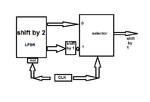ABO_ATHAB
Junior Member level 1
hi every one
today during trying implement dual edge counter i find this post
https://www.edaboard.com/threads/133082/
one of the member add code that work very well , here is the simulink
https://obrazki.elektroda.pl/98_1289953468.gif
can any one help ous and post code or share idea for dual edge LFSR random generator
https://en.wikipedia.org/wiki/Linear_feedback_shift_register
best regards:
m.s
today during trying implement dual edge counter i find this post
https://www.edaboard.com/threads/133082/
one of the member add code that work very well , here is the simulink
https://obrazki.elektroda.pl/98_1289953468.gif
can any one help ous and post code or share idea for dual edge LFSR random generator
https://en.wikipedia.org/wiki/Linear_feedback_shift_register
best regards:
m.s


